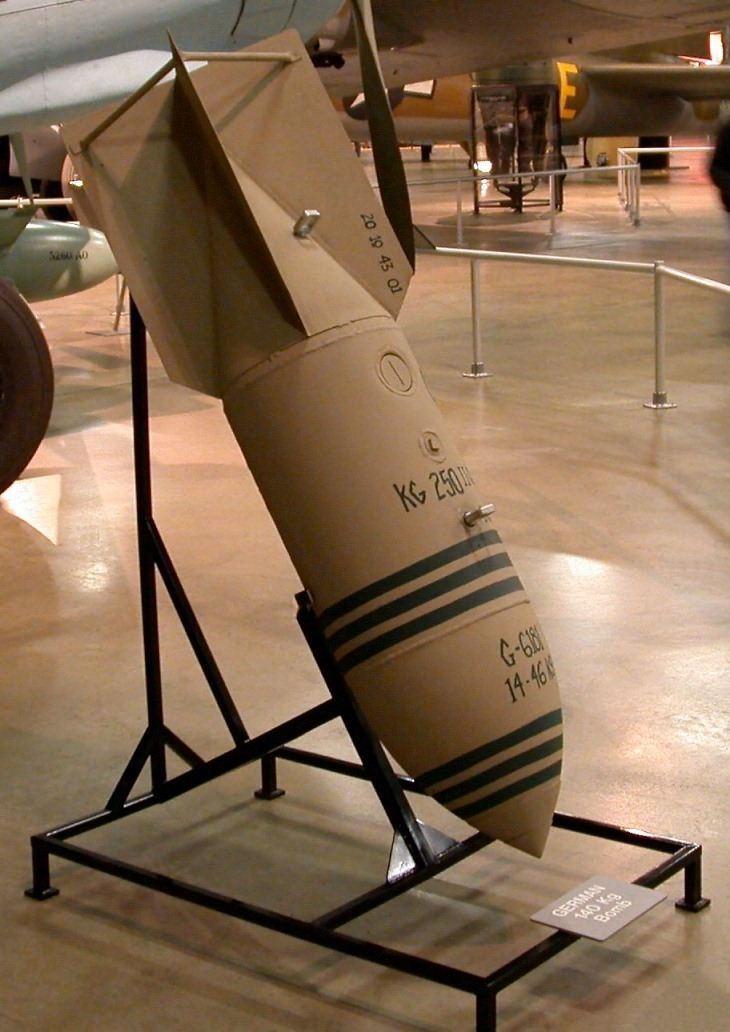The SC 250 (Sprengbombe Cylindrisch 250) was an air-dropped general purpose high-explosive bomb built by Germany during World War II and used extensively during that period. It could be carried by almost all German bomber aircraft, and was used to notable effect by the Junkers Ju 87 Stuka (Sturzkampfflugzeug or dive-bomber). The bomb's weight was about 250 kg, from which its designation was derived.
It was used in the Eastern Front and many other theatres, and was feared for its destructive power. The SC 250 was one of the most commonly used bombs in World War II and used extensively during the Blitz on London.
The bomb consisted of three sections; the nose cone, the body, and the base plate, to which the four-finned tail was attached. With an overall weight of 250 kg (550 lb) the bomb itself was 120 cm (47 in) long, 164 cm (65 in) including the tail, and 37 cm (15 in) in diameter. It contained 130 kg (290 lb) of a mixture of amatol and TNT, and later TNT with additives including wax, woodmeal, aluminium powder, naphthalene and ammonium nitrate. The bomb was held in place by suspension lugs, which could be fitted either to the nose to hold the bomb vertically inside a bomb bay, or to the body if it were slung horizontally below the fuselage or wing of an aircraft.
Type 1Model J: One piece construction of forged steel.Model L: One piece construction of tube steel.Model L2: Two piece construction, nose of forged steel, body of tube steel. Sometimes fitted with a 570 mm (22 in) spike to ensure detonation above ground, called a "Stabo", (Stachelbomben, "Spike Bomb").Type 2Model J: Two piece construction of forged steel.Type 3Model J: Three piece construction; nose of forged steel, body of tube steel, and base of forged steel.Model B: Three piece construction; nose of cast steel, body of tube steel, and base of arched steel case.Model K: Three-piece construction; nose of case hardened steel, body of tube steel, and base of cast steel.The SC 250 could be fitted with a variety of fuzes depending on the target:
Type 25B electric impact fuze. This could be set to instantaneous detonation, short delay (less than 1 second), or for a 17-second delay.Type 17 electric clockwork fuze. This was a time-delay fuze; the Type 17 and 17A could be set for any time between 2 and 72 hours after dropping, while the 17B could be set to detonate between 3 and 135 minutes. To prevent the bomb being defused by Allied bomb disposal personnel they were fitted with:Type ZUS 40 mechanical antiwithdrawal fuze. This was a simple spring-loaded detonator fitted to prevent the removal of the fuze, and resulted in instantaneous detonation if it were moved by more than 15 mm (0.59 in).Type 50 and 50B (called "Type Y" by the British from a distinguishing marking stamped on the face of the fuse) electric anti-disturbance fuze. This used three mercury switches to detonate the bomb if the fuze was disturbed or rotated. John Pilkington Hudson was awarded the George Medal in 1943 for disabling the first Y fuze.Type 38 electric impact fuze. The Type 38 was designed for use at low-level against shipping, while the Type 38sl. was for use as an anti-submarine bomb.Type 59B electric aerial burst fuze. Could be set to detonate 12, 41 or 58 seconds after release.Type 79 electric aerial burst fuze. Could be set to detonate either 3, 10, 25 or 30 seconds after release.On 23 March 2015, an SC250 was unearthed in a building site in Bermondsey, South London. It was safely detonated in a quarry in Kent two days later.A bomb was found in Portsmouth Harbour during dredging work to widen the port's channel in February 2017.ReferencesBibliography"Army Technical Manual TM 9-1985-2/Air Force Technical Order TO 39B-1A-9 German Explosive Ordnance (Bombs, Fuzes, Rockets, Land Mines, Grenades & Igniters)" (PDF). HyperWar. March 1953. Retrieved 15 June 2013. 
